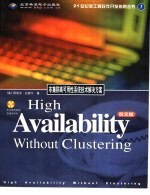图书介绍
非集群高可用性系统技术解决方案 英文版PDF|Epub|txt|kindle电子书版本下载

- (美)斯蒂夫·拉塞尔著 著
- 出版社: 北京:北京希望电子出版社
- ISBN:7900071733
- 出版时间:2001
- 标注页数:214页
- 文件大小:55MB
- 文件页数:223页
- 主题词:网络服务器(学科: 基本知识) 网络服务器
PDF下载
下载说明
非集群高可用性系统技术解决方案 英文版PDF格式电子书版下载
下载的文件为RAR压缩包。需要使用解压软件进行解压得到PDF格式图书。建议使用BT下载工具Free Download Manager进行下载,简称FDM(免费,没有广告,支持多平台)。本站资源全部打包为BT种子。所以需要使用专业的BT下载软件进行下载。如BitComet qBittorrent uTorrent等BT下载工具。迅雷目前由于本站不是热门资源。不推荐使用!后期资源热门了。安装了迅雷也可以迅雷进行下载!
(文件页数 要大于 标注页数,上中下等多册电子书除外)
注意:本站所有压缩包均有解压码: 点击下载压缩包解压工具
图书目录
Contents1
CHAPER 1 Introduction to availability 1
1.1 Availability1
1.1.1 Clustering for high availability2
1.1.2 High availability without clustering3
1.2 Terminology3
1.3 Improving availability5
1.3.1 The cost of the alternative5
1.3.2 Availability for xSeries and Netfinity servers7
1.4 The scope of this book13
CHAPTER 2 Tools for availability management14
2.1 IBM Director16
2.1.1 Advanced System Management18
2.1.2 Setting up alerting18
2.1.3 Capacity Manager27
2.1.4 System Availability Tool31
2.2 Universal Manageability Services(UMS) client33
2.3 Other tools35
2.3.1 Windows performance counters35
2.3.2 Windows resource kits36
2.3.3 Linux performance counters37
CHAPTER 3 Integrated hardware availability features40
3.1 Techniques to improve availability41
3.2 Redundant power42
3.3 Redundant cooling44
3.4 Processors46
3.5 Memory46
3.5.1 Error checking and correcting memory(ECC)47
3.5.2 Chipkill memory48
3.6 Light Path Diagnostics49
3.7 Advanced Systems Management hardware52
3.7.1 Using a direct connection53
3.7.2 Using an Ethernet connection56
3.7.3 Automatic Server Restart58
3.7.4 Remote Supervisor adapter59
3.8 ActivePCI63
3.8.1 Prerequisites for ActivePCI63
3.8.2 Installing ActivePCI software for Windows 200064
3.8.3 Installing IBM Hot Plug for Windows NT 4.0 Package67
CHAPTER 4 Disk subsystem availability74
4.1 IBM xSeries and Netfinity server disk subsystems75
4.2 ServeRAID controllers76
4.2.1 ServeRAID controller families76
4.3 Standard RAIDlevels78
4.3.2 RAID-179
4.3.1 RAID-079
4.3.3 RAID-1E80
4.3.4 RAID-581
4.3.5 RAID-5E82
4.4 Advanced RAID levels82
4.4.1 RAID-0083
4.4.2 RAID-1083
4.4.3 RAID-1E084
4.4.4 RAID-5084
4.5 Servers with integrated RAID controllers85
4.6 Choosing the right RAID Level85
4.6.1 Important parameters86
4.7 Failover RAID adapter pairs86
4.7.1 Configuring a ServeRAID adapter failover pair86
4.7.2 How failover adapter pairs work87
4.8 FlashCopy89
CHAPTER 5 Networking hardware for availability94
5.1 Network adapters95
5.2 Network adapter failover pairs96
5.2.1 How to configure a failover adapter pair96
CHAPTER 6 Keeping the operating system up and running112
5.2.2 Failover adapter pairs in action115
5.3 Load balancing116
5.3.1 Types ofbalance117
5.3.2 Where to deploy load balancing117
5.3.3 Benefits of load balancing118
5.3.4 Adapters that support load balancing119
5.3.5 onfiguring load-balancing adapters120
6.1 Windows NT 4.0127
6.1.1 Hardware compatibility128
6.1.2 Recovering from a blue screen129
6.1.3 Automatically updating recovery information130
6.1.4 Generating system documentation131
6.1.5 Restarting failed services132
6.1.6 Best practices137
6.2 Windows 2000137
6.2.1 Designed for reliability138
6.2.2 Fewer reboots required139
6.2.3 System file protection139
6.2.4 Hardware compatibility141
6.2.5 Recovering from a blue screen145
6.2.6 Reducing recovery time147
6.2.7 Restarting failed services153
6.2.8 High availability storage155
6.2.9 Application repair156
6.2.10 Best practices157
6.3 Linux158
6.3.1 xSeries and Netfinity servers and Linux159
6.3.2 IBM Director client for Linux159
6.4 NetWare162
6.4.1 The NetWare Management Portal162
6.4.2 Portal functions164
CHAPTER 7 Additional availability enhancements172
7.1 Power173
7.1.1 Uninterruptiblepower supplies174
7.1.2 Power fault management software174
7.1.3 Power conditioners178
7.1.4 Independent power circuits178
7.2.1 What it can do for you179
7.2 Electronic Service Agent179
7.2.2 Installation ofESA181
7.2.3 Configuring and testing ESA187
7.2.4 Enabling a system for ESA191
7.2.5 Working with ESA193
7.3 Update Connector Manager198
7.3.1 Installation and configuration ofUCM198
7.3.2 Discovering updates201
7.3.3 Applying updates203
7.4 The other 80210f availability205
7.4.1 Planning and testing205
7.4.2 Operations management207
7.4.3 Training and support208
7.4.4 Change management209
7.4.5 BackuP212
7.4.6 Disaster recovery214